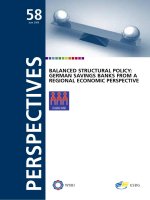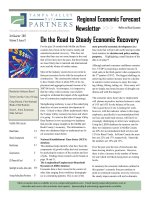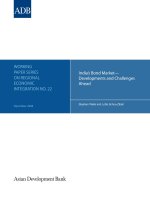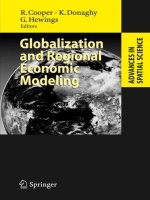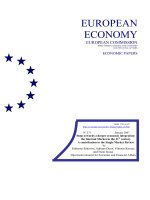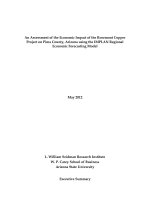Regional economic integration
Bạn đang xem bản rút gọn của tài liệu. Xem và tải ngay bản đầy đủ của tài liệu tại đây (605.16 KB, 47 trang )
International Business
7e
by Charles W.L. Hill
McGraw-Hill/Irwin Copyright © 2009 by The McGraw-Hill Companies, Inc. All rights reserved.
Chapter 8
Regional Economic Integration
8-3
Introduction
Regional economic integration refers to agreements
between countries in a geographic region to reduce
tariff and non-tariff barriers to the free flow of goods,
services, and factors of production between each other
Regional trade agreements are designed to promote
free trade, but instead the world may be moving toward
a situation in which a number of regional trade blocks
compete against each other
8-4
Levels Of Economic Integration
There are five levels of economic integration:
1. a free trade area eliminates all barriers to the trade of
goods and services among member countries, but
members determine their own trade policies for
nonmembers
the European Free Trade Association (between
Norway, Iceland, Liechtenstein, and Switzerland), and
the North American Free Trade Agreement (between
the U.S., Canada, and Mexico) are both free trade
areas
8-5
Levels Of Economic Integration
2. a customs union eliminates trade barriers between
member countries and adopts a common external trade
policy
The Andean Pact (between Bolivia, Columbia,
Ecuador and Peru) is an example of a customs union
3. a common market has no barriers to trade between
member countries, a common external trade policy, and
the free movement of the factors of production
MERCOSUR (between Brazil, Argentina, Paraguay,
and Uruguay) is aiming for common market status
8-6
Levels Of Economic Integration
4. An economic union has the free flow of products and
factors of production between members, a common
external trade policy, a common currency, a
harmonized tax rates, and a common monetary and
fiscal policy
The European Union (EU) is an imperfect economic
union
5. A political union involves a central political apparatus
that coordinates the economic, social, and foreign policy
of member states
The EU is headed toward at least partial political
union, and the United States is an example of even
closer political union
8-7
Levels Of Economic Integration
Figure 8.1
8-8
Classroom Performance System
All barriers to the free flow of goods and services
between member countries are removed, and a
common policy toward nonmembers is established in a
a) Free trade area
b) Customs union
c) Common market
d) Economic union
8-9
Classroom Performance System
NAFTA is an example of a(n)
a) Free trade area
b) Customs union
c) Common market
d) Economic union
8-10
The Economic Case For
Regional Integration
All countries gain from free trade and investment
Regional economic integration is an attempt to exploit
the gains from free trade and investment
8-11
The Political Case For Regional Integration
Linking countries together, making them more
dependent on each other:
creates incentives for political cooperation and
reduces the likelihood of violent conflict
gives countries greater political clout when dealing
with other nations
8-12
Impediments To Integration
Economic integration can be difficult because:
while a nation as a whole may benefit from a regional
free trade agreement, certain groups may lose
it implies a loss of national sovereignty
8-13
The Case Against Regional Integration
Regional economic integration is only beneficial if the
amount of trade it creates exceeds the amount it diverts
Trade creation occurs when low cost producers within
the free trade area replace high cost domestic
producers
Trade diversion occurs when higher cost suppliers
within the free trade area replace lower cost external
suppliers
8-14
Classroom Performance System
When higher cost suppliers within the free trade area
replace lower cost external suppliers
a) The bloc as a whole benefits
b) There is trade creation
c) There is trade diversion
d) External suppliers benefit
8-15
Regional Economic Integration In Europe
Europe has two trade blocs:
The European Union (EU) with 27 members
The European Free Trade Area (EFTA) with 4
members
The EU is seen as the world’s next economic and
political superpower
8-16
Regional Economic Integration In Europe
Map 8.1: Member States of the European Union in 2007
8-17
Evolution Of The European Union
The EU was formed as a result of the devastation of
two world wars on Western Europe and the desire for a
lasting peace, and the desire by the European nations
to hold their own on the world’s political and economic
stage
The forerunner of the EU was the European Coal and
Steel Community, which had the goal of removing
barriers to trade in coal, iron, steel, and scrap metal
formed in 1951
The European Economic Community was formed in
1957 at the Treaty of Rome with the goal of becoming a
common market
8-18
Political Structure Of The European Union
There are five main institutions of the EU:
the European Council - resolves major policy issues and sets
policy directions
the European Commission - responsible for implementing
aspects of EU law and monitoring member states to ensure they
are complying with EU laws
the Council of the European Union - the ultimate controlling
authority within the EU
the European Parliament - debates legislation proposed by the
commission and forwarded to it by the council
the Court of Justice - the supreme appeals court for EU law
8-19
Classroom Performance System
_______ is the ultimate decision making body of the
European Union.
a) Council of the European Union
b) European Parliament
c) Court of Justice
d) European Commission
8-20
Classroom Performance System
_______ is responsible for proposing EU legislation.
a) Council of the European Union
b) European Parliament
c) Court of Justice
d) European Commission
8-21
The Single European Act
The Single European Act:
was adopted by the EU in 1987
committed the EC countries to work toward
establishment of a single market by December 31, 1992
was born out of frustration among EC members that
the community was not living up to its promise
provided the impetus for the restructuring of
substantial sections of European industry allowing for
faster economic growth than would otherwise have
been the case
8-22
The Establishment Of The Euro
The Maastricht Treaty committed the EU to adopt a
single currency
By adopting the euro, the EU has created the second
largest currency zone in the world after that of the U.S.
dollar
The euro is used by 12 of the 25 member states
For now, three EU countries, Britain, Denmark and
Sweden, that are eligible to participate in the euro-zone,
are opting out
8-23
The Establishment Of The Euro
Benefits of the Euro:
There are savings from having to handle one currency, rather
than many
A common currency will make it easier to compare prices across
Europe
European producers will be forced to look for ways to reduce
their production costs in order to maintain their profit margins
It should give a strong boost to the development of highly liquid
pan-European capital market
A pan-European euro denominated capital market will increase
the range of investment options open both to individuals and
institutions
8-24
The Establishment Of The Euro
Costs of the Euro:
National authorities lose control over the monetary
policy
The EU is not an optimal currency area (an area
where similarities in the underlying structure if economic
activities make it feasible to adopt a single currency and
use a single exchange rate as an instrument of macro-
economic policy)
8-25
The Establishment Of The Euro
Since its establishment January 1, 1999, the euro has
had a volatile trading history with the U.S. dollar
Initially, the euro fell in value relative to the dollar, but
strengthened to a five year high of $1.30 in February
2006

